There is some evidence from 6x small studies involving a tiny total of 93 cyclists that strength training (in the gym) slightly helps cycling performance (see footer below). However, on the other hand from the 3x studies that reported data on weight training for runners [15,19,20] there was a disappointing minimal gain. Well it seems runners don’t need to do to the gym then 😜😜.
Here is the data as a chart:
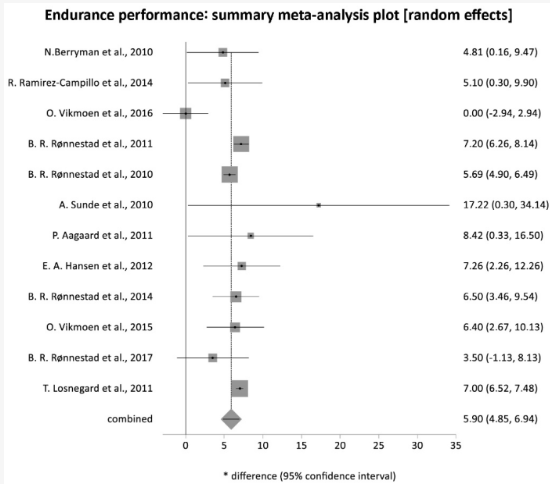
But if you are an endurance athlete, there is another reason to do strength training and that is to offset osteopenia (thin bones) which is a big risk in serious cyclists, and can afflict the upper body of keen runners.
All that said, if you go want to lift weights in the gym, the question today is how much strength training should endurance athletes do? and the answer of less than 120mins might surprise you, because more than this on a regular basis could negatively affect your survival!
Does Weight Lifting Help Longevity?
Previously, I looked at the effect of endurance exercise and everyday activity (eg walking, gardening) on mortality and found two surprises.
There was no lower limit where exercise was not beneficial
There was no upper limit where exercise was harmful
This suggests the “J shaped cardio curve” is either a myth or a measurement artifact.
But what about strength training, how does that influence the above? The answer comes from this new 2022 study by Coleman and colleagues in the Br J Sports Med (LINK)
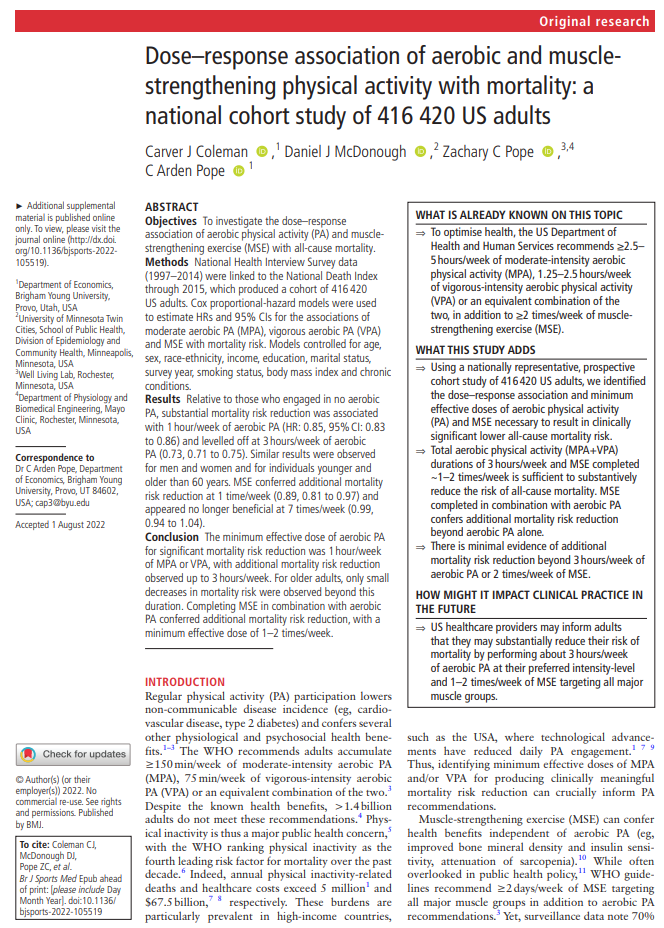
They looked at the impressive National Health Interview Survey data (1997–2014). This incredible dataset began in 1957 and in this paper collected outcomes on almost half a million (416,420) US adults. Models controlled for age, sex, race-ethnicity, income, education, marital status, survey year, smoking status, body mass index and chronic conditions….and the results?
There was no lower limit where strength training was not beneficial
Adding strength to any type of activity or exercise was additionally beneficial.
Large benefits were seen with 3hr/week cardio activity + strength training

Here is the data as a forrest plot chart: aerobic alone = 25% benefit; strength alone 18% benefit; both combined 40% benefit!
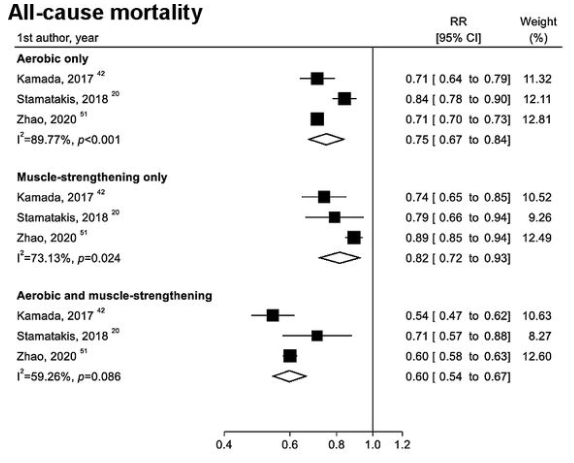
OK fine, so now we know strength training AND endurance training helps mortality, but we don’t know the effect of strength training *dose*. To do this we need to switch to a second paper from Shailendra in Am J Prev Med 2022 (LINK)
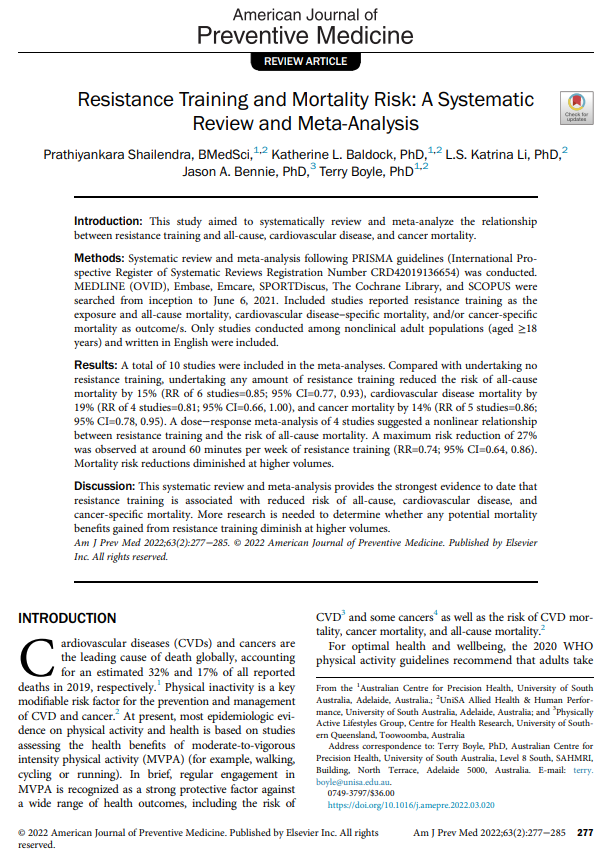
In the meta-analyses, they looked at 6 studies and sure enough compared with undertaking no resistance training, undertaking any amount of resistance training reduced the risk of all-cause mortality by 15%. But only 4 studies examined the key dose−response.
A maximum risk reduction of 27% was observed at around 60 minutes per week of resistance training (RR=0.74; 95% CI=0.64, 0.86). Mortality risk reductions diminished at higher volumes and crossed the zero line at 150mins/week; possibly becoming harmful after that!
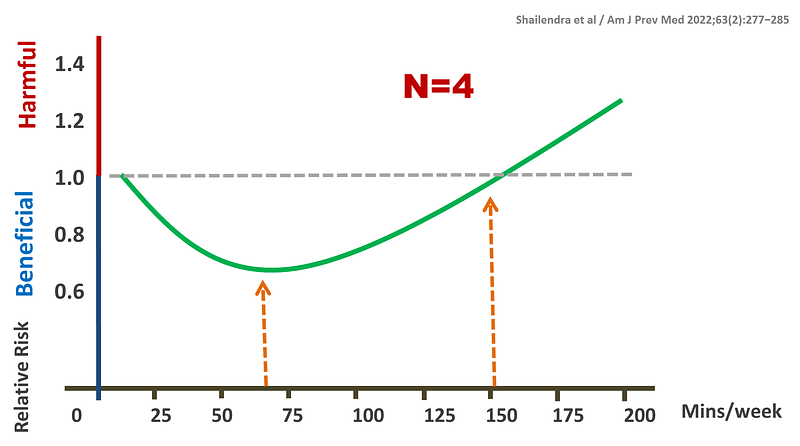
Not sure about you but I wasn’t fully convinced by only 4 studies, but then I found a second new meta-analysis from Momma (2022) with six studies and a total of 236 331 participants, showing the same thing:
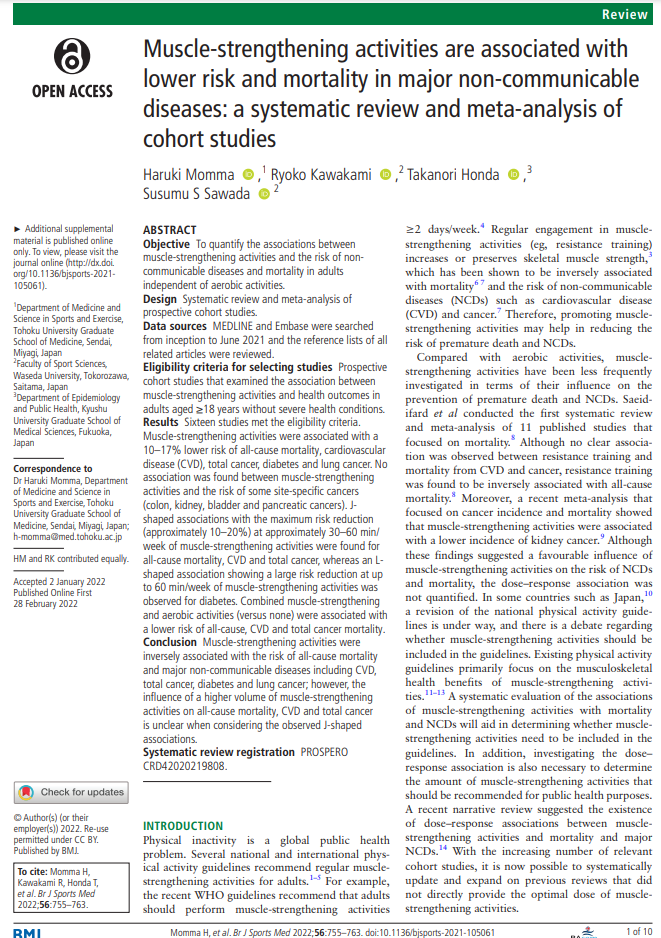
The lowest RR (RR 0.83; 95% CI 0.79 to 0.86) was now observed at 40 min/week of muscle-strengthening activities, and the RR estimate for up to approximately 140 min/week was <1.00 (all-cause mortality, CVD and total cancer all showed similar)

Conclusions
Adding strength training is likely to be a benefit to endurance athletes especially for cyclists (although to be honest the evidence is not strong). Whether you get the ballpark 5% performance gains is debatable. Gains might come from any of:
- taking a rest of excessive endurance training with a gym day
- adding fast twitch muscle function to slow twitch muscles
- building anaerobic strength
- building resilience and flexibility
Weight training benefits seem to be greater in older people and in women. However, the bigger picture, is that you don’t have to do much, in fact it is advisable to do between 30mins and 60mins a week (which could be one session!) the current evidence suggests that doing above 140mins a week might do more harm than good….but how?
I am not 100% sure, but there is a credible theory that too much muscle mass can be a strain on a (relatively) under-developed heart. A 2016 study found 4% higher deaths in 1,578 professional male bodybuilders….but I cannot find any new evidence other than worrying links: https://fitnessvolt.com/bodybuilders-passed-away/
Reference: Weight Training and Cycling
Sunde, A.; Støren, O.; Bjerkaas, M.; Larsen, M.H.; Hoff, J.; Helgerud, J. Maximal strength training improves cycling economy in competitive cyclists. J. Strength Cond. Res. 2010, 24, 2157–2165. [Google Scholar] [CrossRef] [PubMed][Green Version]
Thirteen (10 men and 3 women) cyclists completed the study. The intervention group (7 men and 1 woman) performed half-squats, 4 sets of 4 repetitions maximum, 3 times per week for 8 weeks, as a supplement to their normal endurance training. The control group continued their normal endurance training during the same period. The intervention manifested significant (p < 0.05) improvements in 1RM (14.2%), RFD (16.7%), CE (4.8%), work efficiency (4.7%), and time to exhaustion at pre-intervention maximal aerobic power (17.2%).
Aagaard, P.; Andersen, J.L.; Bennekou, M.; Larsson, B.; Olesen, J.L.; Crameri, R. Effects of resistance training on endurance capacity and muscle fiber composition in young top-level cyclists: Concurrent resistance and endurance training. Scand. J. Med. Sci. Sports 2011, 21, e298–e307. [Google Scholar] [CrossRef]
In 14 cyclists Short-term (5-min) endurance performance increased (3–4%) after SE and E (P<0.05), whereas 45-min endurance capacity increased (8%) with SE only (P<0.05). Type IIA fiber proportions increased and type IIX proportions decreased after SE training (P<0.05) with no change in E. Muscle fiber area and capillarization remained unchanged. In conclusion, concurrent strength/endurance training in young elite competitive cyclists led to an improved 45-min time-trial endurance capacity that was accompanied by an increased proportion of type IIA muscle fibers and gains in MVC and RFD, while capillarization remained unaffected
Rønnestad, B.R.; Hansen, E.A.; Raastad, T. Strength training improves 5-min all-out performance following 185 min of cycling: Strength training and cycling performance. Scand. J. Med. Sci. Sports 2011, 21, 250–259. [Google Scholar] [CrossRef]
20x well-trained cyclists were assigned to either usual endurance training combined with heavy strength training [E+S; n=11 (♂=11)] or to usual endurance training only [E; n=9 (♂=7, ♀=2)]. adding strength training to usual endurance training improves leg strength and 5-min all-out performance following 185 min of cycling in well-trained cyclists.
Hansen, E.A.; Rønnestad, B.R.; Vegge, G.; Raastad, T. Cyclists’ Improvement of Pedaling Efficacy and Performance After Heavy Strength Training. Int. J. Sports Physiol. Perform. 2012, 7, 313–321. [Google Scholar] [CrossRef] [PubMed][Green Version]
Eighteen well-trained cyclists either performed 12 wk of heavy strength training in addition to their usual endurance training (E+S; n = 10) or merely continued their usual endurance training during the intervention period (E; n = 8). The strength training consisted of 4 lower body exercises (3 × 4–10 repetition maximum) performed twice a week. E+S enhanced cycling performance by 7%, which was more than in E (P = .02). Performance was determined as average power output in a 5-min all-out trial performed subsequent to 185 min of submaximal cycling.
Rønnestad, B.R.; Hansen, J.; Hollan, I.; Ellefsen, S. Strength training improves performance and pedaling characteristics in elite cyclists: Strength training in elite cyclists. Scand. J. Med. Sci. Sports 2015, 25, e89–e98. [Google Scholar] [CrossRef]
9 cyclists performed endurance training and heavy strength training (ES) while seven cyclists performed endurance training only (E). heavy strength training leads to improved cycling performance in elite cyclists as evidenced by a superior effect size of ES training vs E training on relative improvements in power output at 4 mmol L−1 [la−], peak power output during 30-s Wingate test, Wmax, and mean power output during 40-min all-out trial.
Vikmoen, O.; Ellefsen, S.; Trøen, Ø.; Hollan, I.; Hanestadhaugen, M.; Raastad, T.; Rønnestad, B.R. Strength training improves cycling performance, fractional utilization of VO 2max and cycling economy in female cyclists: Strength training and cycling performance. Scand. J. Med. Sci. Sports 2016, 26, 384–396. [Google Scholar] [CrossRef] [PubMed][Green Version]
Nineteen female cyclists were randomly assigned to 11 weeks of either normal endurance training combined with heavy strength training (E+S, n = 11) or to normal endurance training only (E, n = 8). adding heavy strength training improved cycling performance, increased fractional utilization of VO2 max , and improved cycling economy. The main mechanisms behind these improvements seemed to be increased quadriceps muscle CSA and fiber type shifts from type IIAX-IIX toward type IIA. . The individual changes in performance during the 40-min all-out trial was correlated with both change in IIAX-IIX fiber proportion (r = -0.63) and change in muscle CSA (r = 0.73).
